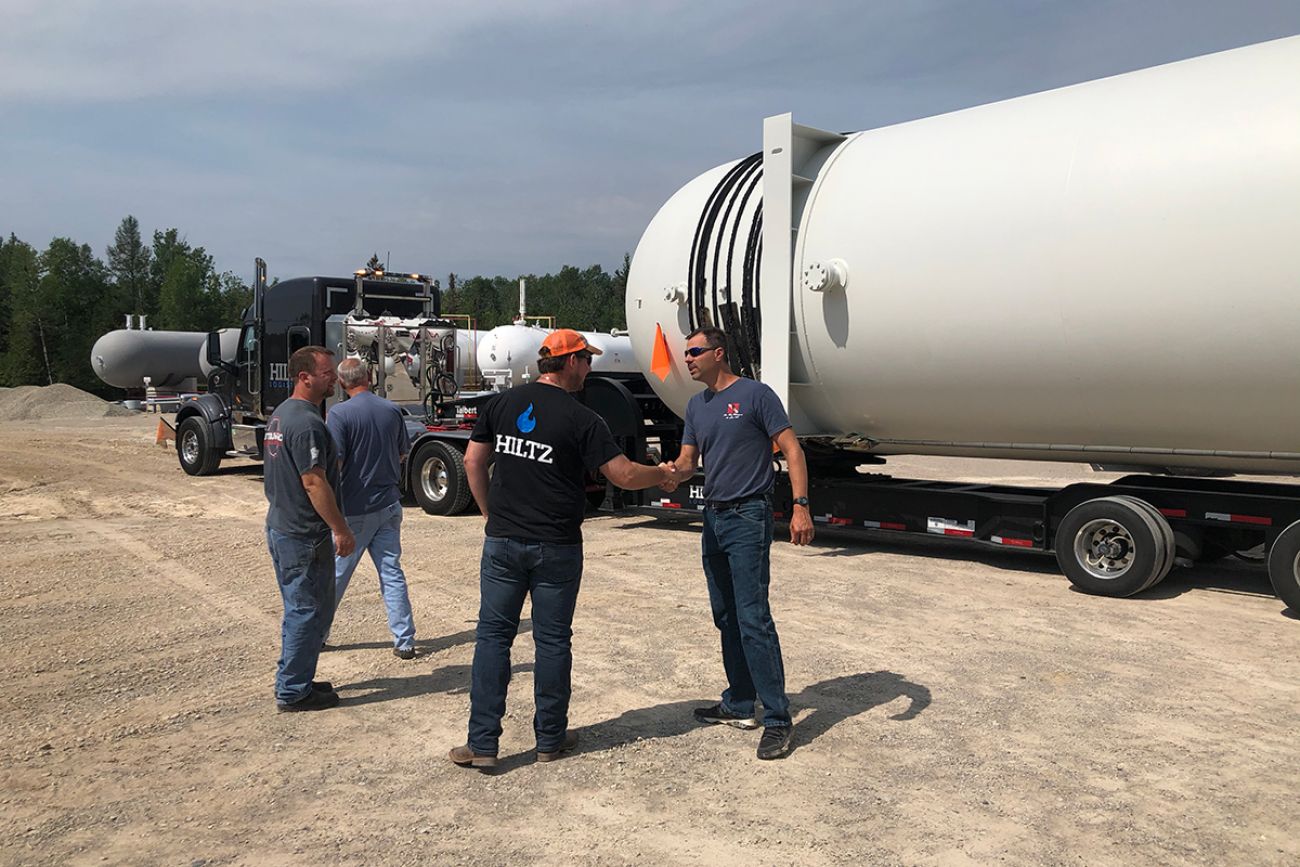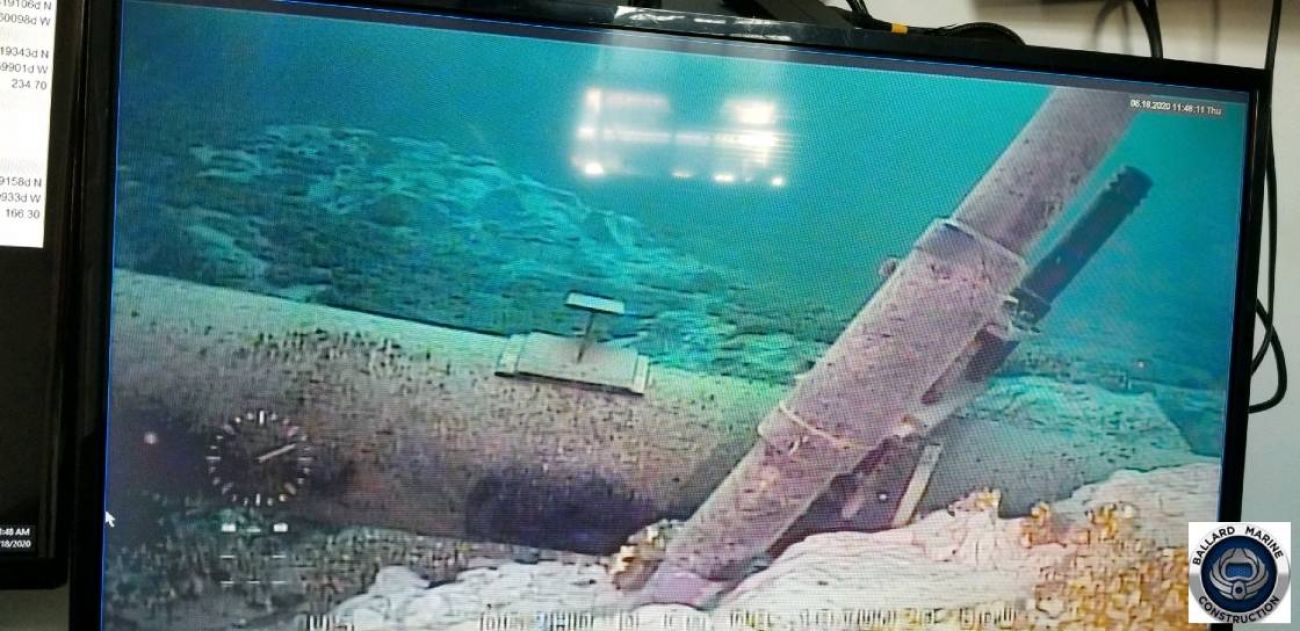With Line 5 closure, a ‘game of chicken’ over how to heat Upper Peninsula

- May 11: Michigan vows to seek Line 5 profits if Enbridge defies shutdown order
- On eve of Line 5 shutdown deadline, Enbridge vows to defy Michigan order
If the Enbridge Line 5 pipeline shuts down next spring, Michigan has a matter of months to find a new way to deliver propane to Upper Peninsula residents who collectively use tens of millions of gallons from the pipeline annually to heat their homes.
But one month after Gov. Gretchen Whitmer announced that she’s giving the Canadian oil giant until May to shutter the 67-year-old pipeline that runs beneath the Straits of Mackinac, her administration still won’t say exactly how Michigan will make up the difference.
Spokespeople for Whitmer did not respond to numerous calls, texts and emails asking about potential contingency plans. Spokespeople for key state agencies told Bridge Michigan they’re studying alternative ways to meet U.P. propane needs, but none identified specific solutions that would be in place by next heating season.
Related:
- Fish, propane, cash: Not everyone loves Enbridge generosity in the Straits
- Is the Line 5 tunnel a bridge to Michigan’s energy future or a bad deal?
And while state officials and industry experts have said they expect the free market to adjust on its own, industry representatives said so far, they’ve made only tentative progress on the infrastructure investments necessary to wean the U.P. off Line 5.
Experts who spoke to Bridge for this article said it’s possible to transition the Upper Peninsula to other propane sources using delivery methods such as truck or rail, but it will take money, time, and a clear strategy — with no guarantee it’s possible to achieve in a matter of months.
“A lot of things have to go right,” said Eric Pardini, a director with Lansing-based Public Sector Consultants, who led a state-commissioned study outlining pathways to transitioning the Upper Peninsula’s propane sector.
“The number of potential solutions gives me optimism, but it doesn’t give me peace.”
In the absence of a detailed plan from the state, Upper Peninsula propane providers complain that they’re left to decide for themselves how they’ll serve their customers next year. Some are pursuing other sources of supply. Others are stalling as Enbridge and state attorneys wage a court battle that could determine whether the shutdown order sticks.
That, Pardini said, sets up a “game of chicken” between the industry and the Whitmer administration over changes that must happen to ensure a Line 5 shutdown doesn’t strand tens of thousands of U.P. residents without a reliable propane supply come next heating season.
Small volume, big impact
By volume, the propane siphoned from Line 5 to supply the Upper Peninsula represents just a fraction of a percent of the pipeline’s 540,000 barrel-per-day capacity.
But nearly 1 in 5 Upper Peninsula households use propane to heat their home — almost quadruple the national average, and more than double the rate of propane-dependency in the Lower Peninsula.
And a large majority of that propane comes from Line 5, with few readily-available alternatives. Enbridge estimates that Line 5 satisfies 65 percent of Upper Peninsula propane demand; Public Sector Consultants estimated it’s even higher, at 87.6 percent.
Fears that a shutdown would compromise Upper Peninsula energy security have been a key sticking point for Line 5 supporters who argue the lakebottom dual-span should remain in place until Enbridge can replace it with a new segment buried in a tunnel beneath the lakebed.
After Whitmer announced the shutdown, Sen. Jim Stamas, R-Midland, went so far as to publish a statement warning it will “freeze Northern Michigan homeowners and workers.”
Pipeline opponents, meanwhile, say those concerns are overblown scare tactics meant to justify keeping the pipeline open despite oil spill concerns arising from the aging pipeline’s exposed position below a busy shipping channel. The total volume of Line 5 propane used in the U.P. is relatively small, they reason, so replacing it should be possible.
“We’ve got 15,000 households that use it. That’s basically the size of Muskegon,” said Liz Kirkwood, executive director of the nonprofit advocacy group FLOW (For Love of Water). “There are challenges, but that doesn’t mean we can’t achieve them.”
And the economic damage from a possible spill, Line 5 opponents argue, would far surpass any economic impact of a shutdown. A 2018 analysis commissioned by FLOW valued the total economic and natural resource impact of a major spill at more than $6 billion.
Natural gas liquids and crude oil destined for facilities in southeast Michigan, Ohio and Canada make up the bulk of the line’s freight, and Enbridge has warned that a Line 5 shutdown also threatens fuel security in the Lower Peninsula. But the Lower Peninsula benefits from better access to propane storage and more readily-available supply alternatives than the U.P., Pardini said.
Natural gas liquids from the pipeline are offloaded at a terminal in Rapid River, near Escanaba, where they are processed to produce 33 million gallons of propane every year. Propane companies then buy the product and use it to fill the backyard pig tanks of customers throughout the region.
Although the terminal is upstream of the Straits portion of the pipeline that Whitmer has ordered shutdown, Enbridge spokesman Ryan Duffy told Bridge the company will not continue delivering petroleum products to Rapid River if Line 5 is shuttered at the Straits.
“You're not going to run a whole pipeline, necessarily, just to deliver a tiny bit of propane, natural gas liquids, to a small market,” Duffy said.
Losing access to Rapid River would spell “disaster” for David Naser, who said his Naser Propane Company gets all of its supply from the terminal, a 40-minute drive from his company’s Powers headquarters.
“We don’t have anywhere else to go,” Naser said, nor the ability to truck propane in from suppliers further afield. “The trucks are expensive. The tankers are expensive, and then you’d have to find drivers, too.”

Several options, for a price
Naser’s predicament illustrates the crux of the challenge of weaning the U.P. from Line 5: It will likely require investment in infrastructure to move more propane by road or rail.
Whitmer, who campaigned for office on a promise to shut down Line 5, appointed a task force in June 2019 to study alternative ways to meet U.P. propane needs.
The Public Sector Consultants study created for the task force concluded there are myriad ways to offset the pipeline through investments in trucking, rail and additional storage capacity. Researchers found the lowest-cost supply alternative — which would involve shipping propane by rail from Edmonton, Alberta to Escanaba, then trucking it to be stored at Rapid River — would raise market propane prices by about 4 cents per gallon.
But it’s not clear how much work it would take to make that switch, in part because key information about existing fuel stocks and infrastructure capacity is kept private, leaving industry representatives in control of how much information they share.
Related stories:
- What Michigan’s move to shut down Enbridge Line 5 means
- Whitmer orders Enbridge Line 5 shutdown, citing easement violations
- Enbridge sues Michigan over Line 5 shutdown order
“From all of our research and everyone we talked to, I’m not even able to say that the current rail capacity is insufficient,” Pardini said, because rail companies wouldn’t supply the information.
The task force recommended 14 steps the state can take to diversify U.P. propane sourcing, from incentivizing storage and encouraging rail investment, to expanding assistance programs that help low-income families weatherize their homes and pay heating bills. The task force report noted that “many of the supply-related steps that the state could take would require significant lead time to implement.”
The state has begun taking at least some steps to carry out the recommendations.
Jeff Cranson, a spokesman for the Michigan Department of Transportation, said the agency has secured a consulting firm to research infrastructure upgrades needed to deliver propane to the U.P. by rail. That study is expected to begin in early 2021 and take eight months to complete, meaning that if researchers begin in January they’ll finish their study just a month before the heating season begins.
Matt Helms, a spokesman for the Michigan Public Service Commission, which oversees energy reliability, said the commission “stepped up its efforts to work with Michigan’s propane industry to identify any factors that might cause or contribute to a propane shortage or disruption.”
Because the propane market is largely unregulated, Helms said, “any response to changing conditions will be market driven.”
The market has begun to respond in some limited ways. NGL Supply Co. recently purchased a rail-serviced propane storage facility in the Eastern U.P. community of Kincheloe, for instance, and plans to upgrade the facility.
But Charles Robertson, a consultant who helps propane companies maintain a secure supply stream, said he believes it would take two or more years for the Upper Peninsula propane sector to secure the combination of trucks, trains and storage tanks necessary to fully offset Line 5.
“It is possible, over the long run, to rectify this situation without the pipeline,” Robertson said, but trying to build out the necessary infrastructure in a matter of months “would be mayhem.”
Free market on the move?
Some suppliers are already working to reduce their dependence on the pipeline.
Derek Dalling, executive director of the Michigan Propane Gas Association, said two of his organization’s members “are building out their own rail storage,” though that represents only a “scratch on the surface” of what’s needed to replace Line 5.
Don Steckman, a U.P.-based general manager for the national propane supplier Ferrellgas, said he is making plans to procure more of his propane from suppliers in other states. The company has contracts at “almost every terminal in the country,” he said, making it easier to absorb the blow of a shutdown at Rapid River.
But many of his competitors are small independent retailers, he said, who don’t have a supply network outside of Michigan. For them, establishing contracts with out-of-state suppliers will be more difficult.
It’s possible, Steckman said, but “could it be done between May and November? No.”
It’s not just a matter of purchasing equipment and securing contracts, said Sen. Ed McBroom, R-Vulcan. The Upper Peninsula lawmaker has long argued that there is no readily available substitute to Line 5 in his home territory because of logistical barriers that “you can’t buy your way out of.”
For example, he said, Michigan law allows heavier trucks on its roadways than neighboring Wisconsin, home of the Superior Propane Terminal, where many providers might get their fuel if Rapid River closed. That means Michigan propane companies may need to swap out their current fleet for lighter trucks. And because they would be driving smaller trucks further distances, they would need more of them.
Hiring drivers could also be challenging: The propane industry faces an industry-wide driver shortage.
“The question isn’t as simple as how many trucks is it going to take,” McBroom said. “It's also personnel, and policies, and all of these second- and third-tier wrinkles.”
Switching to rail is more possible in a short time frame, said Pasi Lautala, director of the Rail transportation Program at Michigan Technological University, who is helping MDOT with its rail study.
Plenty of rail lines crisscross the U.P., with capacity to carry more shipments, he said, although rail transport of propane is only possible on those lines that can carry hazardous substances.
Increasing shipments of propane would require investment in specialized rail tanks and new rail spurs where full tanks could be stored between deliveries, Lautala said. A single rail spur, he said, can cost as much as $1 million. A representative from The Greenbrier Companies, which manufactures railcars, told Bridge that high-pressure train cars used to ship propane cost up to $150,000 and lease for around $1,000 a month.
State and industry leaders would have to decide who pays, Lautala said, and “it’s hard to believe that the private industries would be willing to foot all of the capital investment,” for infrastructure needs arising from a state-ordered shutdown.
McBroom said the Republican-controlled legislature is unlikely to pony up, either.
But it’s hard to come by clear estimates of just how many rail tanks or new spurs the U.P. might need, and supporters of a shutdown argue there may already be resources in the system that could be put to better use.
Jim Lively, program director at the Groundwork Center for Resilient Communities, a Traverse City advocacy group, has been studying potential impacts of a shutdown. He believes those who predict dire shortages and insurmountable barriers to truck or rail transport “are bluffing.”
“It’s just hard for me to imagine that this is that dire,” he said, noting that industry predictions of supply disruptions and rising fuel prices during a brief Line 5 shutdown this past summer never came true.
And there are other possible solutions, too, Lively said. Expanding programs that increase home energy efficiency in Upper Peninsula homes could reduce propane demand. And financial assistance programs could help low-income families absorb any price increase associated with a shift to truck or rail-based propane transport.
Lively contends finding solutions before next heating season will require bringing key players together. He hopes to organize a meeting early next year with propane industry representatives, state officials and others to begin the discussion.
For now, Naser said his propane company is banking on the idea that Line 5 will still be operational next year. He wants more evidence that a shutdown will happen before he’ll start seriously considering alternatives to his pipeline-dependent propane supply.
“I have to go with the notion that Rapid River is going to stay open,” he said, “because [without it] we'd all be up a creek without a paddle.”
Michigan Environment Watch
Michigan Environment Watch examines how public policy, industry, and other factors interact with the state’s trove of natural resources.
- See full coverage
- Subscribe
- Share tips and questions with Bridge environment reporter Kelly House
Michigan Environment Watch is made possible by generous financial support from:
Our generous Environment Watch underwriters encourage Bridge Michigan readers to also support civic journalism by becoming Bridge members. Please consider joining today.
See what new members are saying about why they donated to Bridge Michigan:
- “In order for this information to be accurate and unbiased it must be underwritten by its readers, not by special interests.” - Larry S.
- “Not many other media sources report on the topics Bridge does.” - Susan B.
- “Your journalism is outstanding and rare these days.” - Mark S.
If you want to ensure the future of nonpartisan, nonprofit Michigan journalism, please become a member today. You, too, will be asked why you donated and maybe we'll feature your quote next time!






